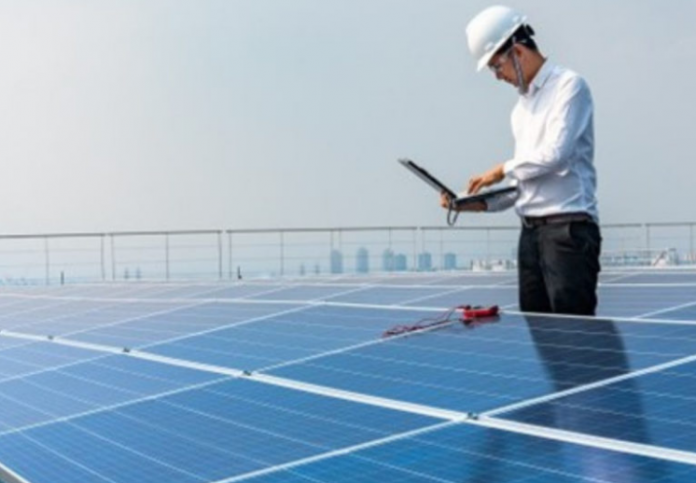Mercom India hosted a webinar on December 8, 2021, to understand the critical role operations and maintenance (O&M) companies play in optimizing the performance of solar assets while mitigating challenges.
The panelists took a close look at the competitive landscape of O&M and asset management, discussed the cost optimization techniques through new technology adoptions, and assessed the cost trends and asset owners’ expectations.
The panel included Kiran K R, Technology Head at Adani Green Energy; Gokulendu Bharadwaj, India Sales Head at SenseHawk; Kartikeya Narayan Sharma, Director – Strategy, Sunsure Energy; and Tummuru Manohar Reddy, Assistant General Manager at Azure Power.
Priya Sanjay, Managing Director of Mercom India, moderated the webinar.
O&M service providers have a significant opportunity in the rapidly growing solar market. India has around 41 GW of operational large-scale solar projects and about 52 GW under development. Of the 41 GW of operational solar projects, around 9 GW of solar projects have been operational for five or more years.
O&M challenges faced by solar developers
Solar developers face challenges in balancing the O&M costs with asset optimizing techniques. The owners of aging projects face cost escalation risks due to higher O&M labor costs and supply chain issues.
Kiran said, “It takes a year to develop a solar project with 50 MW to 100 MW capacity. However, O&M is required for 25 years. So, the challenges related to O&M keep on changing with time, and it also depends on the capacity of the project. Currently, maintaining efficiency and procuring water for cleaning the panels and slower technology penetration are major concerns.”
As far as the selection of in-house O&M or third-party service providers is concerned, Kiran said that O&M is moving towards a hybrid model with the availability of advanced technologies, big data, and increasing project capacities.
Dwelling on the O&M challenges developers face, Reddy said the unavailability of skilled O&M labor is critical for developers. Other significant concerns are modules’ efficiency, replacing outdated spare parts, technology changes, disposal of wastes, and warranty for spare parts beyond five years.
Shedding light on issues faced by O&M service providers due to Covid-19, Sharma said the O&M cost increased due to staff vaccination, rapid workforce testing at project sites, and new labor policies. The price of cables and spares also increased, affecting the overall O&M costs.
Advanced technologies
As the solar sector matured in India towards competitive bidding, tariffs went down drastically. Last year, the Gujarat Urja Vikas Nigam Limited’s (GUVNL) auction discovered a record low tariff of ?1.99 (~$0.0270)/kWh for 500 MW of solar projects. However, the project costs increased due to supply chain issues and higher prices of solar modules and commodities like steel, aluminum, copper. This forced solar developers to utilize advanced technologies for O&M of solar assets to increase efficiency while reducing costs.
Bhardwaj from SenseHawk said, “The cost of solar tariff reduced to ?2 (~$0.026)/kWh while O&M cost is going upwards as labor costs increase. To compensate for those costs, O&M developers need to utilize advanced technologies. Drones would help them with the thermal imaging of the project. Drones could cover 100 MW of solar project within three days, and a report could be prepared within seven days. It would also provide a root cause analysis to take corrective action on damaged modules. This would save time and resources and reduce O&M costs while increasing asset performance.”
Talking about advanced technologies, Kiran said sensors for modules, high computational capacity, data collection software, weather intelligence systems, and network connectivity are critical advanced technologies. Earlier, it used to take around two days to find a damaged module and replace it. Now with sensors, it can be done quickly.
He said that with higher computational capacity, drones could provide real-time data. The O&M service provider can analyze the data in no time with the help of artificial intelligence. Weather intelligence systems provide accurate forecasts to know how it affects generation. Overall, combining all these advanced technologies help developers make sound decisions to improve assets’ efficiency while saving capital.
Sharma echoed Kiran’s thoughts. He said remote monitoring technology, robotic cleaning, and computerized monitoring and management system (CMMS) would be central to O&M of solar projects. A remote monitoring system could provide significant data and analytics to provide details of the entire portfolio for large-scale solar projects. CMMS would be essential for centralizing off-line data of the project’s maintenance. Security costs account for 30% of the overall O&M cost, and installing CCTV at the project’s site could reduce this considerably.
To maintain the efficiency of aging solar projects, Kiran suggested maintaining a digital diary that tracks and save data related to efficiency and maintenance record from the commissioning of the project to the end of the project life. Projects should be designed to provide room for retrofitting in the future. This would help developers add advanced technology to improve project life and efficiency.
“Waste management is a significant issue for aging projects, and we are moving towards a situation where production cost is less than disposal. As of now, the industry does not have any solution for waste disposal on a large scale,” Kiran added.
The panelists agreed that technological innovation and its large-scale deployment would drive down the O&M costs of solar projects.
Advanced Technology Adoption Vital to Cut O&M Cost, Increase Solar Project Efficiency
Robotic cleaning and drones will play a critical role in reducing O&M costs
Source:MERCOM
ViaHarsh Shukla






